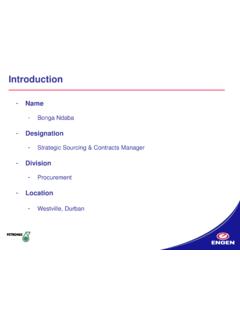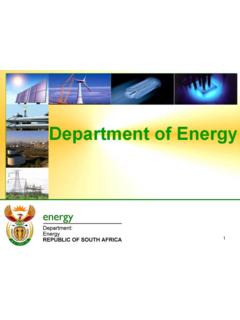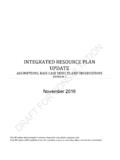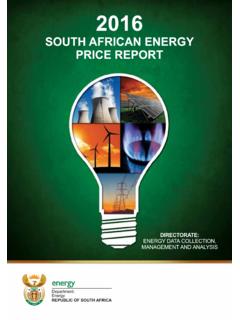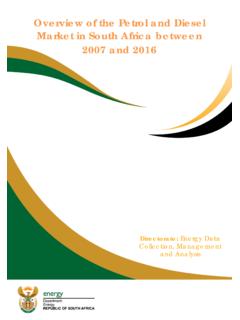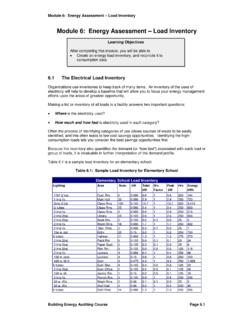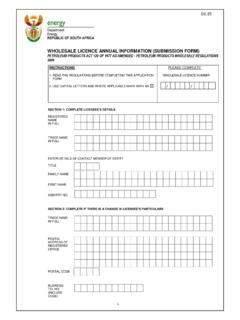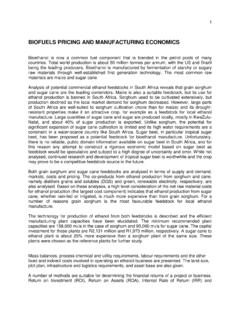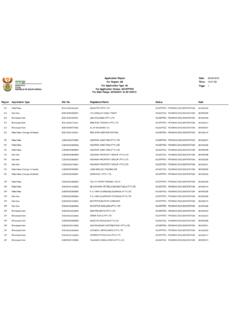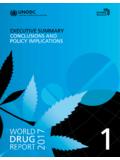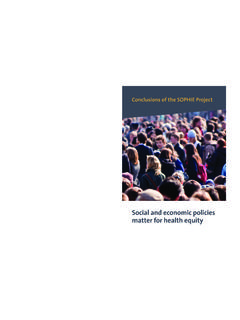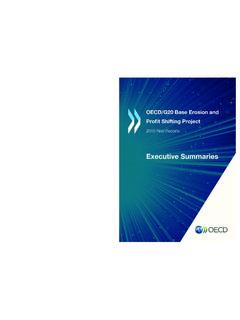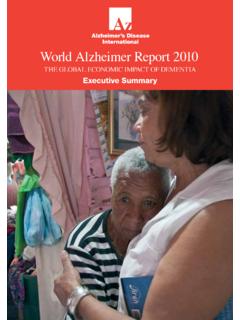Transcription of Executive Summary of the Draft Integrated Electricity ...
1 Executive Summary of the Draft Integrated Electricity resource plan for South Africa - 2010 to 2030 IRP 2010 22 October 2010 Compiled by the Department of Energy based on inputs and recommendations by the Interdepartmental Task Team The Inter Ministerial Committee (IMC) has approved this Executive Summary of the findings and conclusions, drawn from a scenario modelling process, as well as the recommended Balanced Scenario, which is the basis for the Draft IRP 2010 that is to be used for public consultation. TABLE OF CONTENTS 1.
2 OVERVIEW AND Executive Summary .. 1 2. THE IRP AND ITS PURPOSE .. 4 3. THE IRP DEVELOPMENT PROCESS .. 5 4. THE IRP SCENARIOS MODELLED .. 8 Base Case .. 9 Emission Limit 1 .. 10 Emission Limit 2 .. 10 Emission Limit 3 .. 10 Carbon Tax .. 11 Regional Development .. 11 Enhanced 11 Balanced Scenarios .. 11 Energy Efficiency .. 12 5. EVALUATING SCENARIOS .. 15 6. RATING THE SCENARIOS .. 20 7. SCORING THE SCENARIOS .. 21 8. RECOMMENDED BALANCED SCENARIO .. 22 9. CONCLUSIONS .. 28 APPENDIX AA .. 30 Page 1 of 47 1. OVERVIEW AND Executive Summary Long term planning, whilst essential, is fraught with uncertainty.
3 This is more so today than ever before due to the pace of global change on the political, economic, social, technological and environmental fronts. The biggest challenge in all long term planning lies in finding a sensible balance between the divergent views and expectations of the different parties involved. These views fall broadly into two categories: desired/wished for (could be) outcomes and required (must be) inputs or outputs, which are subject to various constraints. Such could be and must be parameters are the interdependent variables of planning.
4 Scenario planning is an effective tool to find this balance. A scenario is not a plan but rather a glimpse of an extreme future, where a particular outcome or input is amplified in a modelling process to observe the effect this has on the other interdependent variables. The balanced scenario is created by an assessment of all scenarios to establish a balance between desired future outcomes and the realities of known constraints. The balanced scenario is the basis for the ultimate government approved risk/policy adjusted plan .
5 The primary objective of the Integrated resource plan (IRP 2010) is to determine the long term Electricity demand and detail how this demand should be met in terms of generating capacity, type, timing and cost. However, the IRP 2010 also serves as input to other planning functions, inter alia economic development, funding, environmental and social policy formulation. The accuracy of the IRP 2010 is improved by regular reviews and updates as and when things change or new information becomes available.
6 For this reason all long term plans should be considered as indicative rather than cast in concrete . The proposed policy adjusted IRP aims to achieve a balance between an affordable price for Electricity to support a globally competitive economy, a move to a more sustainable and efficient economy, a move to create local jobs, the demand on scarce resources such as water and the need to meet nationally appropriate emissions targets in line with global commitments. It supports the development of the Southern and Central African region by stimulating the development of hydro power projects in the region and provides a catalyst for further economic development due to increasing energy security.
7 The plan supports a GDP growth trajectory of on average over the next 20 years. It requires 52248 MW of new capacity in order to meet the projected demand and provide adequate reserves. It assumes at least 3420 MW of demandside management programmes, as well as a gradual reduction in Electricity intensity due Page 2 of 47 to increased efficiency and a diversification to secondary and tertiary sectors in the economy. It however still assumes a significant primary sector built on the extraction and beneficiation of natural resources that the country is blessed with.
8 The scenario evaluation process confirmed that the Revised Balanced Scenario represents a fair and acceptable balance considering the divergence in stakeholder expectations and key constraints and risks, for example: Affordability/Funding availability; Reducing carbon emissions; New technology uncertainties such as costs, operability, lead time to build etc; Water usage; Job creation; and Security of supply. The Draft IRP sets out the outcome of the first round of work in government on an Integrated Electricity plan for the next 20 years.
9 It is released for public comment and consultation. In parallel with this process there will be further technical work in government that will, among others, look at the following: 1. How to increase the contribution of solar energy beyond the 600 MW in the proposed scenario, and if possible commence with it earlier than the proposed 2014, in light of the potentially large economic multiplier; 2. Viable opportunities and targets for biofuels and biogas and the incorporation of them earlier than 2020, for the same reason; 3.
10 Measures to ensure that the generation capacity anticipated in the IRP 2010 is achieved as efficiently and timeously as possible, with the best possible outcomes in terms of economic growth, development and employment; 4. Measures to minimise the impact of Electricity pricing decisions on poor households, labour-absorbing sectors and industrial competitiveness; 5. Measures to drive local production and supplier development of relevant technologies; and 6. The required reduction in the energy intensity of the economy and a costing of demand-side management measures.
